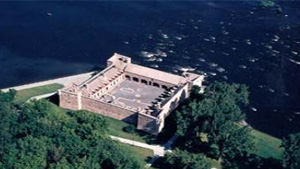Volumetric Reconstruction
At a time when the word reconstruction sends shivers down the
spine of many heritage professionals, it can be easy to ignore that
not all reconstructions are created equal. Such is the case with
many later Canadian reconstruction projects that fall under the
category of volumetric reconstructions.
A volumetric reconstruction uses an architectural frame devoid
of historic details to create a sense of the original structure.
These masses serve as a visual aid by communicating the dimensions and plan
of a building while not attempting to include decorative features
where there is no data to support them. Therefore, this approach
avoids the historical romanticism and potential falsification of
typical reconstruction projects. Furthermore, the resulting
structure can preserve original ruins, shielding them from the
elements. In these ways, volumetric reconstructions attempt to
bridge the goals of conservation and interpretation which can seem
irreconcilable through traditional reconstructions.
communicating the dimensions and plan
of a building while not attempting to include decorative features
where there is no data to support them. Therefore, this approach
avoids the historical romanticism and potential falsification of
typical reconstruction projects. Furthermore, the resulting
structure can preserve original ruins, shielding them from the
elements. In these ways, volumetric reconstructions attempt to
bridge the goals of conservation and interpretation which can seem
irreconcilable through traditional reconstructions.
One of the best known examples of volumetric reconstruction is
the Benjamin Franklin House in Philadelphia, Pennsylvania but there
are a number of Canadian examples. Fort Chambly  National Historic Site of Canada in
Chambly, Quebec is a typical volumetric reconstruction using modern
materials. The Big House reconstructions within the perimeter
walls of Lower Fort Garry National Historic Site of Canada in
Selkirk, Manitoba suggests the original building on the exterior
but the interior is contemporary and serves as an interpretation
centre. Here, archaeological remains were protected and care was
taken to distinguish between the original and recreated
structures.
National Historic Site of Canada in
Chambly, Quebec is a typical volumetric reconstruction using modern
materials. The Big House reconstructions within the perimeter
walls of Lower Fort Garry National Historic Site of Canada in
Selkirk, Manitoba suggests the original building on the exterior
but the interior is contemporary and serves as an interpretation
centre. Here, archaeological remains were protected and care was
taken to distinguish between the original and recreated
structures.
The volumetric reconstruction of the blast furnace of Forges du Saint-Maurice  National Historic Site of Canada in
Trois-Rivières, Quebec, is unique in that it emphasizes the
industrial process that took place at the site rather than the
architecture that housed it. Dedicated a National Historic Site in
1920, it was recognized as the beginnings of Canada's iron industry
and as the motivation for the establishment of the first Canadian
industrial town. Sieur François Poulin de Francheville, seigneur of
Saint-Maurice, established Forges du Saint-Maurice in 1730. The
complex closed in 1883, after more than 150 years of operation.
National Historic Site of Canada in
Trois-Rivières, Quebec, is unique in that it emphasizes the
industrial process that took place at the site rather than the
architecture that housed it. Dedicated a National Historic Site in
1920, it was recognized as the beginnings of Canada's iron industry
and as the motivation for the establishment of the first Canadian
industrial town. Sieur François Poulin de Francheville, seigneur of
Saint-Maurice, established Forges du Saint-Maurice in 1730. The
complex closed in 1883, after more than 150 years of operation.
The Quebec climate posed considerable challenges to both the
interpretation and conservation of the site. The area is covered by
snow approximately half the year, hiding the archaeological
remains. Leaving the ruins exposed to as many as 350 freeze-thaw
cycles per year could have caused severe damage. Therefore,
the mere consolidation and presentation of the archaeological
remains was a challenging undertaking.
In 1981, after a decade long historical and archaeological
research programme, the decision was made to protect the remains
and take a contemporary approach to the interpretation of the
Forges du Saint-Maurice architecture and the industrial process in
the form of a volumetric reconstruction. The work completed by the
firm of Gauthier, Guité and Roy enclosed the archaeological remains
while keeping them visible to the public. The frame of the building
closely follows the plan of the original building. This frame is
coupled with replicas of significant machinery placed at
historically accurate locations. From this presentation visitors
can more easily understand how the complex was used to fulfill its
industrial purpose.
Volumetric reconstructions show a very different approach to
site conservation and interpretation than earlier Canadian historic
site reconstruction projects. These differences speak to the wide
variety of preservation techniques that have been used across
Canada over the years to try and protect our heritage.